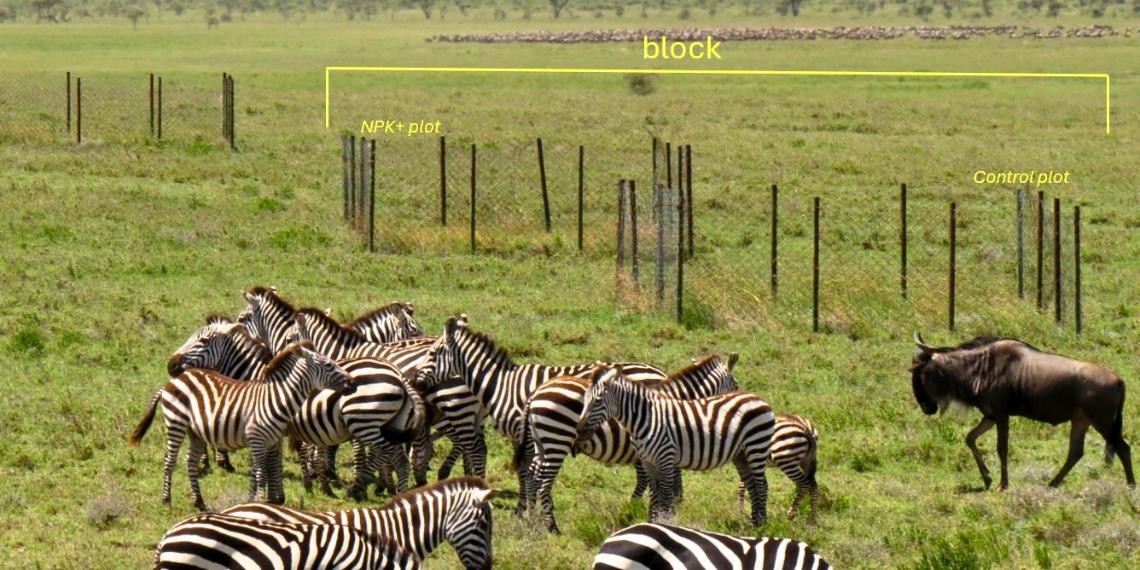How Does your Garden Grow? Global Study Highlights the Need for Precision Fertilization

The idea was simple: fence, fertilize, repeat. In the face of looming fertilizer shortages and the need to feed an ever-growing human population, a global team of scientists affiliated with the Nutrient Network is investigating how and when fertilizer actually works — or not.
The study, recently published in Scientific Reports, was spearheaded by Dr. Oliver Carroll, a postdoctoral researcher working in Dr. Andrew MacDougall’s group in the Department of Integrative Biology. Studying grasslands around the world, the international team has shown that fertilization often fails to increase plant biomass — but predicting failure is challenging.
“We found that, a quarter of the time, fertilizer actually fails,” says MacDougall. “We were interested in figuring out the model that maximizes production and minimizes input.”
The strategy of fertilizing “everywhere, all the time” is widespread in rich countries, yet comes with high environmental and financial costs and is, ultimately, unsustainable. The high rate of failure in Carroll’s study highlights the need for targeted fertilization, both to use fertilizer stock responsibly and reduce adverse environmental impacts.
The production of fertilizer — most often a combination of nitrogen, potassium, and phosphorus — is a resource-intensive process. While nitrogen is abundant in our atmosphere as a gas, converting it into a form that plants can use requires huge amounts of energy.
“It’s incredibly fossil fuel-demanding to produce nitrogen for fertilizer,” says MacDougall, “and we’re running out of fossil fuels.”
The demand for phosphorus is also predicted to increase. Phosphorus is a non-renewable resource that was originally sourced from bird guano and animal bones; it is now mined intensively.
“Mining phosphorus can create landscapes that look like the sand planet in Star Wars — completely dead,” explains MacDougall.
The environmental costs of fertilization extend beyond production: once fertilizer is applied, nitrous oxide volatilizes into the environment.
“Nitrous oxide is one of the three main greenhouse gases, along with carbon dioxide and methane,” says MacDougall. “These emissions occur in addition to fertilizer washing into our groundwater and causing problems like hypoxia.”
Because fertilizer relies on non-renewable resources — fossil fuels for nitrogen conversion and mined phosphorus — the supply will eventually become limited. The only uncertainty is precisely when this will happen, although some researchers have predicted that we will hit peak phosphorus by 2035. Impending shortages are already driving up the financial cost of fertilizer.
Identifying when and where fertilizer does not work is one way to reduce fertilizer use and safeguard our stores.
“Precision fertilization is about only applying fertilizer when you need it: you save money and supply by not applying it when it doesn’t work,” explains MacDougall. “You maximize your crops while minimizing the nutrient input.”
The global team set up the same experiment in 61 grassland sites around the world. Each site had six fenced plots, half of which were treated with a standard fertilizer mix while the other half acted as controls. Plant growth was monitored annually for at least seven years and up to 15.
The sites were spread on six continents and covered a wide range of grasslands, from tundra in Svalbard to savannah in the Serengeti.
“This was a globally unprecedented dataset where we added nutrients to areas that had never been fertilized before, and asked how many times this treatment failed to increase plant growth,” says MacDougall.
The project’s global scale allowed researchers to test for global patterns in responsiveness; to their surprise, they found none. Rather, it became clear that non-responsiveness depends on a complex suite of factors, which are nearly impossible to predict when applying fertilizer in the spring.
“The crystal ball will never exist,” says McDougall. “You can improve fertilizer effectiveness armed with some prior knowledge, but you can’t get the golden combination of highest yield with the least fertilizer.”
An interesting pattern did, however, emerge: arid sites with fewer plant species were more likely not to respond to fertilizer.
“In contrast, sites that are species-rich tended to be better at avoiding nutrient failure,” explains MacDougall. “The odds are better that these grasslands include species that can grow in arid conditions, and can thus benefit from the addition of fertilizer.”
This suggests that transitioning agriculture from monocultures to polycultures could be another strategy to increase the effectiveness of fertilization.
The need for intensive agriculture to respond to the needs of a huge, and growing, human population is here to stay. MacDougall points out that the time to act is now, before fertilizer shortages and pollution become too severe.
“We might lose yield, but we might also avoid adding nutrients when they won’t work,” says MacDougall.
Transitioning to precision fertilization today is one way to sow the seeds of tomorrow’s sustainable agriculture.
This study was funded in part by the University of Guelph’s Food From Thought program, supported by the Canada First Research Excellence Grant and the Arrell Food Institute.
Read the full study in the journal Scientific Reports.
Read about other CBS Research Highlights.